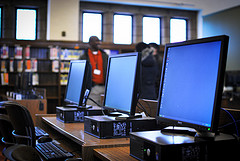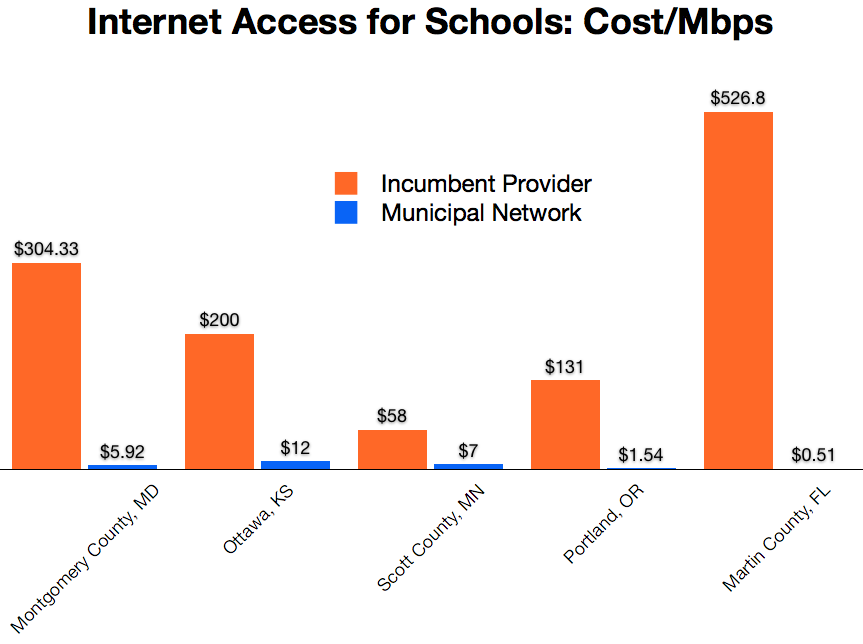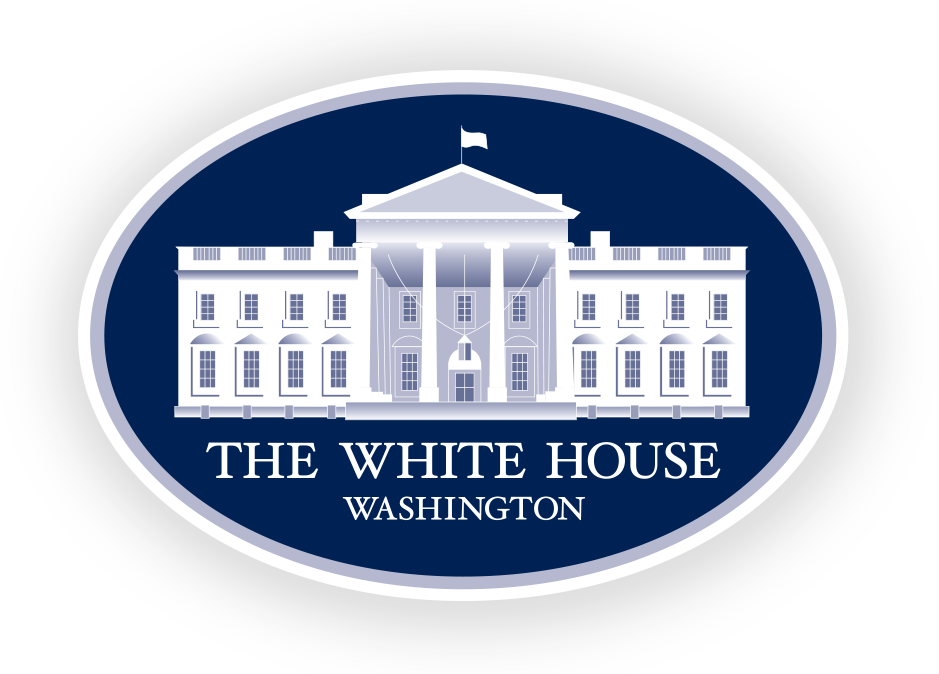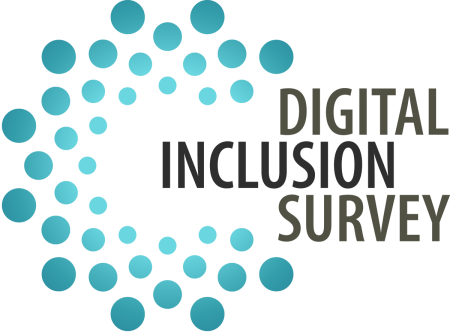
Fast, affordable Internet access for all.

Community anchor institutions play a critical role in bridging the digital divide. These networks that connect government buildings, libraries, and schools are often called “institutional networks” or “I-Nets.” Since the start of MuniNetworks.org, we have noted the ways these institutions have expanded services and saved money. Now, these stories have been compiled into one quick-reference resource.
As franchise agreements run out with incumbent service providers, public institutions often struggle to renegotiate contracts at sustainable prices. Other communities have been left behind altogether by large cable and telephone companies and cannot get the high quality Internet access needed for their libraries or schools.
With 30% of U.S. households without a broadband connection at home, schools and libraries are portals to digital learning tools, social services, and job applications. A local government self-provisioning a fiber network to connect these facilities is often the most cost-effective way to ensure these essential entities have affordable and reliable Internet access.
In this page, we detail the many times schools and libraries have used municipal networks to save money, increase Internet access, and provide better services. We also note how these municipal institutional networks can be incrementally expanded beyond institutions to businesses and homes, creating city-wide connectivity. Check out the page.

Community Anchor Institutions, such as public libraries and schools, are among the first places people go to access the Internet when they cannot access it at home. With 30% of the United States without a broadband connection at home, libraries and schools are essential for access to social services, job applications, and digital learning tools. These institutions, however, may not themselves have the capacity to meet the increasing demand for Internet access.
That can be a really big problem. With many states requiring online testing, schools need to have adequate bandwidth, so that networks do not crash at key moments. Some schools have to ration Internet access - while some students are testing, no one else is allowed to use the Internet. This means no video-streaming educational videos or remote learning classes while testing takes place. Educational opportunities shrink as students and teachers have to forego the most up-to-date online resources because of this bandwidth shortage.
The major barriers to high quality Internet access for community anchor institutions are cost and availability. National carriers like AT&T often do not provide the needed capacity at affordable rates. Municipal networks, however, are locally controlled and attuned to local needs. They treat community anchor institutions like a fundamental building block of society, not a profit center to be exploited.
72.2% of libraries help patrons access employment databases, and 58.8% of libraries face budget constraints when increasing their bandwidth.
63% of schools do not meet the ConnectED Current Goals for high speed connectivity which impacts nearly 40 million students in grades K-12.
-- Education SuperHighway’s Connecting America’s Students: Opportunities for Action
The federal E-rate program provides more than $2 billion in funding each year to support Internet access at public schools and libraries. The E-rate program, however, does not go far enough in helping these entities achieve high-capacity, reliable, and affordable Internet access. In too many cases, E-rate simply helps schools and libraries to afford connections priced at exorbitant levels from national carriers. Below, we detail the many benefits of local governments connecting their own community anchor institutions with self-provisioned networks - often called “institutional networks” or "I-Nets".
Learn more
Keep up to date with all things community broadband by subscribing to a once-per-week email with stories about community broadband networks.
Internet access is already crucial for community anchor institutions and will only become more important as society continues to incorporate technological advances into every aspect of life. Self-provisioning often results in higher capacity connections that are more reliable, and most importantly for local budgets, much more predictable in terms of future costs. Operating an institutional network, communities can plan years in advance for upgrades and have greater security in long term budgeting rather than worrying about the incumbent provider raising rates.
For example, Martin County in Florida had been leasing lines from Comcast to connect the schools and public buildings, but its 10-year franchise agreement was about to expire. With Comcast demanding a stunning price increase, Martin County instead built an underground fiber network with much more redundancy than Comcast offered. Compared to leasing lines, Martin County expects to save an estimated $30 million over the next twenty years. Now Martin County does not fear rate hikes or unexpected outages from Comcast’s network.
In talking with some schools that have transitioned from leased lines to operating their own network, some have reported that network management requires less staff time because the modern technology behind a wide-area network largely runs itself. If something goes wrong, staff have the information they need to diagnose and repair rather than having to wait on hold for a CenturyLink call center to begin investigating a problem.
This chart of five different school districts across the U.S shows some of the savings schools have experienced with municipal networks. The orange is the original provider’s exorbitant price for each Mbps per month. The blue is the price from the municipal network. The savings are stunning.

Sources for the graph
MuniNetworks Public Savings Fact Sheet and Breaking the Broadband Monopoly
For more information about costs and savings, dig into these examples of savings to community anchor institutions:
Ammon, Idaho: municipal network lowers prices, increases capacity for schools after State Education Network dispute with CenturyLink disrupts service.
Ottawa, Kansas: the schools save $3,000 a month and get double the bandwidth.
Staunton, Virginia: the schools used to pay $2,000 a month just to lease fiber, but now they’re connected for free.
Increased Capacity, Expanded Services
Libraries and schools have used the increased Internet capacity of some municipal networks to expand services and enhance their educational materials. Rural districts can use remote instruction via video-streaming to offer more foreign language and science classes. Communities have crafted innovative programs for students to explore how high-speed Internet access can be used in the classroom for more individualized and self-paced learning. These educational experiences cannot be achieved without high-capacity Internet access.

Southwest Georgia: some schools are leveraging the better Internet access to bring STEM education, such as live interactive science demonstrations, to students in rural classrooms.
Chattanooga, Tennessee: the public library has dedicated an entire floor as a maker space, encouraging entrepreneurship and the latest technological innovations.

Expansion Beyond Institutional Networks
One of the many benefits of institutional networks is that communities can use the assets and knowledge from building those connections for economic development and other policy goals. For instance, when building the fiber to connect schools and libraries, smart communities install extra fiber that can be used to connect local businesses or form the backbone of a citywide network in the future if that becomes feasible. Many local governments have found that after building a high-speed institutional network, local businesses clamor for access as well.
Santa Monica is a great example of a community that started by self-provisioning community anchor institutions and has gone on to create many benefits for businesses and residents with both the savings and assets from the municipal network.
Without incurring any debt, the city built an expansive fiber network. They started by connecting municipal buildings and community anchor institutions with a $530,000 investment. Then, they expanded the network through grants for intelligent traffic systems and the savings from discontinuing expensive leased lines.
The city saved $400,000 the first year and $700,000 each subsequent year. With the extra fiber, Santa Monica provides better Internet access to local businesses and leases fiber to other service providers. The money from the municipal network is reinvested in the community, encouraging economic development. See our case study for more details.
To learn more about the benefits of community networks providing Internet access to libraries and schools, check out our multimedia resources.
Community Broadband Bits Podcasts
These podcasts aim to be around 20 minutes long and feature issues related to libraries and schools.
| Episode | Title | Synopsis | Guests | Transcript |
| 79 | Don Means on Libraries and White Spaces | Explanation on TV white spaces wireless technology | Don Means | Transcript 79 |
| 71 | Education SuperHighway Wants Better Broadband for Schools | Education SuperHighway's approach to ensure better Internet connection to all schools and the role of community to achieve this goal | Evan Marwell | Transcript 71 |
| 46 | North Georgia School Brings Gig To Schools, Jobs to Region | The origin of the North Georgia Network and its economic and social impact on the region | Paul Belk | Transcript 46 |
| 43 | Carroll County Explains Many Benefits of County Owned Fiber | How Carroll County Public Network started and the benefit its community network provides | Gary Davis | Transcript 43 |
| 39 | Moultrie City Manager Discusses Origins of CNS Network in Georgia | The origin of CNS network in Georgia and the benefits of the network for local schools and community savings | Mike Scott | Transcript 39 |
Conferences, presentations, hearings, and other research
Looking for even more information about libraries, schools, and Internet access? Here are archives of conferences, presentations, hearings, and other research.

Community-Based Broadband Solutions Report PDF January 2015 The Executive Office of the President
The White House report features the savings to schools and libraries provided by locally controlled community networks.

Connecting America’s Students: Opportunities for Action Report PDF April 2014 Education SuperHighway
This report examines E-rate spending and underscores the importance of Internet access in schools. The report attempts to answer why the connectivity gap persists and provide solutions to increase Internet access.

2013 Digital Inclusion Survey of Libraries digitalinclusion.umd.edu From the University of Maryland Funded by the Institute of Museum and Library Services
Each year, the University of Maryland releases a survey of digital information services that libraries across the U.S. offer. The reports highlight inequities in Internet access and the changing role of libraries.

Connected Communities in an Age of Digital Learning: a Vision for a 21st Century E-rate Program Video Archive February 27, 2014 New America Foundation
This webcast concerned the modernization of the E-rate program and increasing Internet access at libraries and schools. Featured speakers included representatives from the Institute of Museum and Library Services, the U.S. Department of Education, New America’s Open Technology Institute, the Albemarle County (VA) Public Schools, and the Richland Library (SC).

Schools, Health & Libraries Broadband (SHLB) Coalition www.shlb.org
The SHLB is a nonprofit organization formed in 2009 to support affordable, high-capacity broadband at anchor institutions. They develop and promote policies and programs that further connectivity in communities.

National Association of Telecommunications Officers and Advisors (NATOA) www.natoa.org
A professional association of telecommunications officers and advisors that deal with communication policies and programs in local governments.
Photo of library computers courtesy of the Knight Foundation
Photo of library headquarters from the public domain
Hamilton, Ohio, has entered into a partnership with local firm, CenterGrid, to use city-owned fiber to boost economic development. The firm will offer Internet access and data transport to local businesses via existing infrastructure as the two enter into a five-year pilot project agreement, reports the Journal-News.
The city's business incubator, the Hamilton Mill, is the initial pilot site where emerging businesses are already receiving high-speed connectivity:
“As the initial pilot site, CenterGrid’s service has resulted in the Mill receiving network connectivity that is better than 83 percent of Internet connections throughout the US — that is huge,” Chris Lawson, executive director of the Hamilton Mill said. “For the types of companies that we are attracting, this level of connectivity is imperative for them to be successful.”
A press release from CenterGrid describes rates as economical, competitive, and determined by individual business requirements. According to the press release, entrepreneurs at The Mill are already taking advantage of the service:
"We've wanted a better high-speed internet option for quite some time. Now having something locally provided by the City of Hamilton and CenterGrid makes the idea that much more appealing. This high-speed circuit will allow us to transform our IT infrastructure and deliver value to our business," said Jon Corrado, IT Director at Tedia.
In 2014, the community of Hamilton connected local schools to city fiber allowing them to obtain Internet access from the Southwest Ohio Computer Association Council of Governments (SWOCA-COG). That opportunity decreased school connectivity costs while increasing bandwidth.
Winston-Salem struck up a smart deal with the North Carolina Department of Transportation in 2011. Four years later, that agreement allows the city to move forward with its vision for an I-Net.
The Winston-Salem Journal reports that the City Council recently approved $826,522 for networking equipment to light up city owned fiber installed by the NCDOT. The agency has been upgrading area traffic control systems, a project estimated at around $20 million. Winston-Salem took advantage of the opportunity and paid the agency $1.5 million to simultaneously install its own fiber in the state conduit.
“The city was able to have the network built at only the cost of the fiber,” [city information systems department Chief Officer Dennis] Newman said. “They (state traffic contractors) are running fiber optic cable all around the city to where all the traffic lights are at. This will enable us to connect to all facilities all over the city – fire stations, public safety centers, satellite police stations – right now there are about 40 locations that we have targeted to connect to.”
As is typically the case, Winston-Salem currently pays private providers for connections at each facility but when the new I-Net is up and running, they will be able to eliminate that expense. The new voice and high-speed network will outperform current connections, described in the article as "out-of-date." City officials also told the Journal that some municipal offices have no Internet access at all but will be connected to the new I-Net.
A number of other communities have taken advantage of partnerships with state and federal transportation agencies during traffic signal upgrades. Martin County, Florida; Aurora, Illinois; and Arlington, Virginia saved considerably by collaborating during similar projects.
In June, Boulder released a Request for Proposals (RFP) as it seeks a consultant to conduct a broadband feasibility study. A PDF of the RFP is available online.
The city currently has 179 miles of fiber in place serving 60 city facilities; there is an additional 36 miles of empty conduit. This network interfaces with the Boulder Valley School District's network within the city and in other areas of Boulder County. It also connects to Longmont's network and to a colocation facility in Denver.
The city is also home to BRAN - the Boulder Research and Administration Network. The city, the University of Colorado at Boulder, the National Center for Atmospheric Research and the Department of Commerce Laboratories share ownership of the BRAN fiber network which interconnects their facilities.
Last fall, Boulder joined a number of other Colorado communities whose voters chose to reclaim local telecommunications authority, revoked in 2005 under Colorado State Bill 152.
The city established a Broadband Working Group earlier this year to investigate ways to bring better connectivity to Boulder. They created a draft vision, included in the RFP:
Draft Vision: Gigabit Broadband to Boulder Homes and Businesses
(May 21, 2015)
Our vision is to provide a world-class community telecommunications infrastructure to Boulder for the 21st century and beyond, facilitated by new access to the public’s local telecommunications assets. We acknowledge that broadband is a critical service for quality of life, as is the case with roads, water, sewer, and electricity. Every home, business, non-profit organization, government entity, and place of education should have the opportunity to connect affordably, easily, and securely. Boulder’s broadband services will be shaped by the values of the community.
Dublin, Ohio's Dublink has been saving public dollars and spurring economic development since 2002. The gigabit fiber network is on the verge of a 100 gigabit upgrade. The Dublin Villager reports that in early May the City Council voted to implement the 100-Gigabit Dublink Ignite program.
According to the Villager:
The city has budgeted $865,000 over the next six years to complete the project, [City Manager Dana] McDaniel said, and will also use $300,000 in state funds and $360,000 from the Ohio Academic Resource Network for use of additional fiber optics for the project.
Increasing the city's fiber capability will allow the Dublin to provide fiber optics to older office buildings and make then more attractive, McDaniel said.
In addition to bringing fiber to a greater number of office buildings, the project may even lead to "fiber to the cubicle."
As we reported in 2014, Dublin collaborated with the Ohio Academic Resources Network (OARnet) to create CORN, also known as the Central Ohio Research Network. This new 100 gigabit initiative plans to encompass those partnerships so companies can potentially access OARnet and CORN.
Dublin operates a "meet me" room at a local data center and anticipates using that facility as a place were a number of ISPs can compete for commercial customers.
According to a detailed memo from Dana McDaniel [PDF], the city has calculated significant benefits for local businesses. Here are just a few (emphasis ours):
Indiana County, Pennsylvania's County Commission recently voted to use its fiber optic network for telephone service reports the Indiana Gazette. The change will allow the county to save $67,000 over the first five years. Indiana County is located on the west side of the state and is home to approximately 89,000 people.
The upgrade will allow the county to eliminate two-thirds of its phone lines by taking advantage of the network that was installed as part of Indiana County's public safety radio system. Phones in the courthouse, jail, district justices’ offices, a convalescent facility, the Indiana County Airport, the county parks and the departments of Children and Youth Services and Human Services will all be on the new system.
From the Gazette article:
“This is just the beginning of the savings we’ll see from the fiber optic network,” Baker said. Coming soon will be lower costs for county government’s Internet service.
Minnesota's Dakota County community leaders are planning to expand their existing fiber optic network, reports Blandin on Broadband's Ann Treacy. She attended a recent County Commissioner's meeting in which commissioners approved $1.2 million to add another 500,000 feet to the network.
Dakota County plans to perform some upgrades in addition to the expansion. They hope to collaborate with municipal and state government as well as a local school district. In addition to connecting more public facilities, a key benefit of this expansion will be to improve traffic signals along several busy corridors.
Dakota County is taking advantage of transportation projects and its dig once policy to install conduit and fiber. This project will also add redundancy and capacity to the existing network and create potential connections to an industrial park. By sharing the cost of the expansion and the maintenance, each participating entity will see many benefits at a fraction of the cost from leasing from an incumbent provider.
The Dakota County Broadband Initiative recently began a campaign to approach local community leaders in order to offer info on the potential benefits of further leasing fiber to private businesses. Nearby Scott County, which offers connectivity to a number of businesses, has successfully used their fiber for economic development.
The SunThisWeek reported on a March Burnsville City Council meeting where Consultant Craig Ebeling spoke on behalf of the Initiative:
Private-sector telecom providers don’t have the capital to extend fiber widely, he said, echoing findings in the Design Nine study. Meanwhile, Scott County “smacked us in the face” with its fiber advantage, he said. It’s no time for a “hide your head” approach, [Council Member Dan] Kealey said.
“Shame on us for not being long-sighted enough to figure that out before,” he said.
Vallejo recently hired Jory Wolf, CIO from Santa Monica, to help develop a fiber optic master plan, reports the Times Herald. A fiber network now controls the city's intelligent transportation system (ITS) and Vallejo wants to build off that asset to encourage economic development.
Wolf was the key player behind Santa Monica's master plan, which led to the development of its Institutional Network and CityNet, a fiber optic network for business connectivity. According to the article, Vallejo's master plan is expected late this fall.
Last year, we highlighted a letter to the editor from resident Chris Platzer who suggested using Vallejo's ITS fiber network as the foundation to deploy a municipal network. A number of communities we study take advantage of fiber assets and conduit put in place as part of transportation control, including Martin County in Florida; Arlington, Virginia; and Aurora, Illinois. The Vallejo ITS includes approximately 11 miles of fiber and was built in the 1990s.
In March, city staff included the same idea as part of their recommendations. They also advised developing a joint trench ordinance and fiber upgrade policy, collaborating with nearby Benicia, and joining Next Century Cities.
From the article:
According to staff, a joint trench ordinance would be essential in upgrading municipal infrastructure as it would allow the timing of installation of conduit to coincide with other underground construction.
Staff is also investigating the possibility of the city drafting a cooperative agreement with Benicia, to provide “better telecommunications service, faster implementation, lower costs ...”
Also on Thursday, the city announced that it has joined Next Century Cities.
San Francisco has long been considered a modern, glittering, tech capital. For years its leaders have struggled with ensuring residents and businesses actually had next-generation Internet access as AT&T and Comcast only provide the same basic services that are available in most cities. In a recent Backchannel article, Susan Crawford discusses how the City by the Bay is taking steps to develop its vision, its long-term plan, and hopefully a network that will improve connectivity in a city of over 800,000 8.5 million.
San Francisco has developed an Information and Communication Technology Plan, which still needs approval from the City Board of Supervisors. According to the article, the plan calls on the city to take an incremental approach on its path to improved connectivity. They plan to use a similar method as Santa Monica by connecting municipal facilities - many of which are already connected via fiber - and then shedding expensive leased circuits. By eliminating that expense, the city will cut $1.3 million for Internet access and networking services from its connectivity costs.
Last year the City also put dig once policies in place, a decision other communities attribute as one of the keys to a cost-effective deployment. Like Santa Monica, the City currently leases dark fiber to ISPs. They plan to entice more ISPs who want to bring broadband to residents and businesses by expanding that practice. San Francisco plans to streamline the process and work with developers on strategically linking new developments to Internet hubs with dark fiber.
As Crawford notes, the City has created free Wi-Fi in select areas of town with plans to serve public housing and commercial corridors. Miquel Gamiño, San Francisco's CIO, told Crawford they hope to make Wi-Fi available on a larger scale: